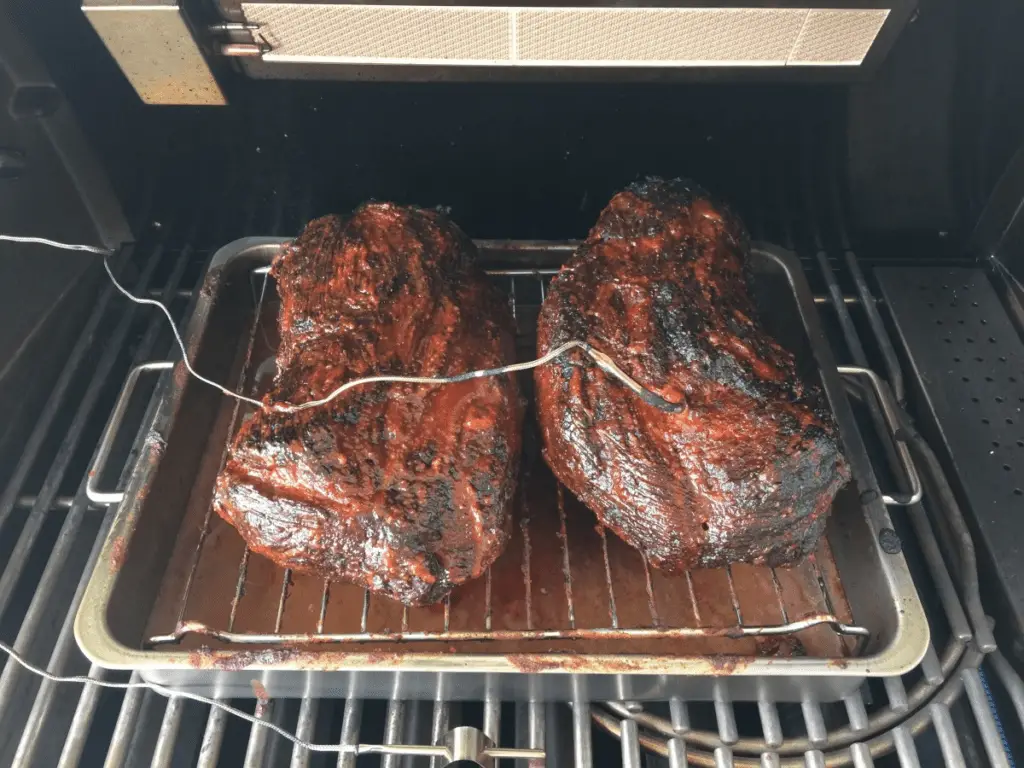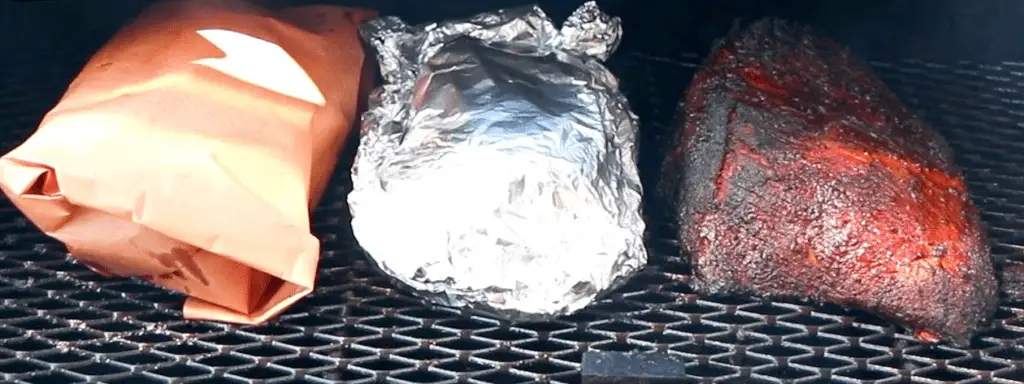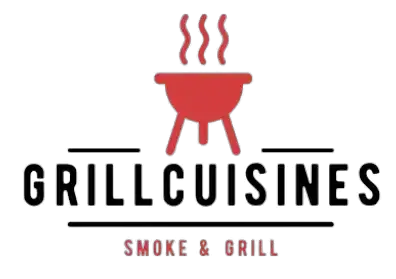Share via:
Achieving the perfect brisket internal temperature is the key to a tender, juicy, and flavorful brisket. But it often involves encountering the infamous “brisket stall.”
It’s a phase in the brisket-cooking journey that can instill intimidation and frustration. If you’ve ever found yourself in full lockdown mode or having nightmares about the brisket stall, fret not; you’re not alone.

In this grillcuisines.com guide, we will explore:
— Why brisket stalls? and What Temp Does Brisket Stall? The brisket stall at various temperatures, from 125°F to 190°F
— The science behind brisket stall and expert tips to navigate Brisket stall at 180.
— What to do when brisket stalls? Along with busting many myths related to brisket stalling.
When Does Brisket Stall?
Brisket is one of the difficult meats to cook and the purpose of smoking is to break its meat fibers down to the point where they soften and are easier to eat.
This is done when the brisket reaches a certain internal temperature, however, the internal temperature of the meat can stop rising at around 155-165°F for hours in the middle of the process, rendering it unable to cook further.
This break in the cooking process is called a brisket stall. If you’ve ever faced the brisket stall, you know it can be an anxiety-inducing experience.
The stall’s duration can be unpredictable, ranging from a mere 30 minutes to a grueling four hours.
Understanding the Brisket Stall
The brisket stall is more than just a roadblock; it’s a critical part of the cooking process. To conquer it, we must first understand what it is and why it occurs.
You want to cook brisket at 225 F but it has stopped cooking called the brisket stall and the internal temperature has halted at 165 F.
Brisket stall occurs due to a process called ‘evaporative cooling. It is synonymous with a water cooler where air passes through a water barrier, evaporates the upper layer of water, and passes into the atmosphere through a fan.
Inside a smoker, the temperature rises, causing brisket meat to sweat. This moisture evaporates, causing the meat to cool down. Just like how we feel cooled down after sweating.
The smoker’s temperature keeps going up, the brisket keeps sweating, and moisture keeps evaporating, causing the meat to cool down gradually.
It’s like the conflict between the hot and cold elements within the brisket. The heat wants in, the cold wants out, and they meet in the middle, resulting in a temperature plateau.
Eventually, the cooling effect balances the high temperature and causes the brisket’s internal temperature to stall. This is the brisket stall, and it stays till all moisture of the brisket is evaporated and the smoker can start heating up again.
A brisket can develop a hard, rough bark at the top after the stall. Hence, it is so important to wrap the brisket at the right moment so it to not lose a lot of moisture and to cook evenly and on time.
You can also read more about brisket’s internal temperature here.
What Temp Does Brisket Stall: Brisket Stall temperature
It is important to know “when and what Temp does brisket stall?” Brisket usually stalls at an internal temperature of 155 F to 165 F. A number of variables can affect the internal brisket stall temp.
Factors Leading to a Stall
Several factors can contribute to a brisket stall:
- Temperature Fluctuations: A sudden drop in smoker temperature can trigger a stall. Maintaining a consistent smoker temperature is crucial.
- Insufficient Smoke: Inadequate smoke production can slow down the cooking process. Ensure you have enough wood chips or pellets to maintain consistent smoke.
- Brisket Size: The size of the brisket roast matters. Larger roasts take longer to cook, and frequent monitoring can inadvertently cause a stall due to temperature fluctuations.
How long does a Brisket stall last?
For example, if you cook your brisket at a low temperature of 225 F, then it is guaranteed that the brisket stall will last for a long time.
A temperature of 250 F is ideal and might help in reducing the brisket stalling time to about 1 to 2 hours. Similarly, an unwrapped brisket will also stall for longer than compared to a wrapped one.
One thing is for certain, you need to change some variables to beat the stall. If you do nothing, the stall is likely to last for more than 4 hours and ruin your dinner plans.
Many pitmasters go the long and slow smoked brisket route but high and fast have had better results in beating the brisket stall.
Busting Brisket Stall Myths:
There are a lot of common myths associated with brisket stalling and it’s important to understand them as well, in order to avoid them in the long run and to become an experienced pitmaster.
Myth 1: Latent heat lipid phase transition
This leads people to believe that the heat within the smoker causes fat to melt, which causes the stall while smoking a brisket.
This might be true, but it is not the main or only reason for the stall and may not play a huge role within the brisket stall.
Myth 2: Protein denaturation
Another misconception is that people believe the proteins within brisket meat are damaged completely and cause the brisket to stall or sometimes halt the entire cooking process.
This is especially not true, as there are many ways to save the tough collagens of a brisket through various wrapping techniques.
Myth 3: Fat rendering
This is a similar misconception to the latent heat lipid phase transition but with a different name tag.
It also means that the brisket fat melting within the smoker’s high heat causes the brisket to stall, which is entirely not true as moisture plays the main role in balancing out the smoker’s internal temperature. Fat does not evaporate!
How To Deal With The Brisket Stall
There are many methods to overcome a brisket stall, but ultimately, the key is to exercise patience and allow the cooking process to run its course.
Some pitmasters prefer an unwrapped approach which may increase the brisket stall time further. Wrapped methods to stop brisket from stalling are more convenient and provide a much juicier brisket.
It saves about one hour of cooking time. I researched and outlined the various methods through which to stop the brisket stall easily and quickly.
It is important to remember that many people do not wrap their brisket as soon as the stall starts rather; they wait a little bit before they begin the wrapping process.
The brisket stall temperature of 175 F has been found to be optimum for the wrapping process to ensure thorough cook on the brisket as well.
1. Texas Crutch
The optimum temperature for the wrapping process when cooking a brisket typically falls in the range of 160°F to 170°F (71°C to 77°C). This is often referred to as the “Texas crutch” method, where you wrap the brisket in foil or butcher paper to help accelerate the cooking process while ensuring thorough and even cooking.

Here’s how it works:
- Cook the brisket unwrapped: Start by smoking or roasting the brisket uncovered at a lower temperature, typically around 225°F to 250°F (107°C to 121°C). This allows the meat to develop a flavorful bark on the outside.
- Wrap at the right temperature: When the internal temperature of the brisket reaches around 160°F to 170°F (71°C to 77°C), it’s a good time to consider wrapping it. This temperature range is often associated with the stall, where the meat’s temperature can plateau for a while.
- Use foil or butcher paper: You can choose to wrap the brisket in either aluminum foil or unwaxed butcher paper. Both methods work well, but butcher paper allows for some moisture escape while still tenderizing the meat.
- Continue cooking: After wrapping, return the brisket to the smoker or oven. Wrapping helps to power through the stall more quickly, and it also helps to retain moisture, making the meat tender and juicy.
- Monitor temperature: Continue cooking the wrapped brisket until it reaches your desired internal temperature. For a tender brisket, you’ll want to aim for an internal temperature of around 195°F to 205°F (90°C to 96°C). However, the exact temperature may vary based on your preferences for tenderness.
- Rest the brisket: Once the brisket reaches the desired internal temperature, remove it from the heat source, and let it rest, still wrapped, for about 30 minutes to allow the juices to redistribute. This resting period is crucial for a juicy and flavorful brisket.

The most common method of beating a stall is tightly wrapping the brisket in aluminum foil. The foil is an exceptional barrier and halts the process of evaporative cooling.
Now the moisture trapped inside the foil is like cooking the brisket within a liquid to halt the stall and keep the cook moving forward.
But a problem with this method may be that the smoked brisket comes out mushy and very soft. A few pit masters swear by wrapping the brisket after its brisket is completely finished cooking.
This helps in reducing the crispiness but not losing it completely either.
2. Butcher Paper
Now, the method is similar to the foil wrapping method, but here the difference lies in the material of the wrapping. Butcher paper is porous, which means it is permeable.

Hence, fat and moisture get absorbed and pass through the wrap, but at a steady and slow rate. This can help in reducing the brisket stall, but not as considerable as the Texas crutch method.
However, the outer layer of brisket, i.e., the bark steers clear of becoming too mushy.
3. Aluminum Foil Boat
Now, this is a rather new technique that may need a lot of mastering, but what it implies is that the brisket is wrapped in a boat-like formation, i.e., around the edges only. This protects against drying out but also makes sure the top is crisp and tough.
This boat keeps the juices around the brisket and breaks the brisket stall fairly early as well.
4. Unwrapped method
Now, many people do not believe in the wrapping method, which means they wait for the stalling process to stop on its own without interference.
However, this also means that it may take more than seven hours for the brisket stall to stop. The brisket is then wrapped in foil overnight to soften its bark.
5. Start early and rest
A brisket stall may be unavoidable, but missing out on dinner is not. You should always start early when you plan to smoke a brisket.
Even if the time for a brisket stall is a lot, you don’t lose dinner plans. And in case you finish earlier, you can always rest the brisket to make it less crunchy and tough.
Many people follow this overnight brisket method, also called the low and slow method, to avoid waiting for the stall to end and for a thoroughly cooked brisket.
It is safe to use an electric smoker for such purposes, but also, use a good internal thermometer with an alarm system for if your smoker heats up too much or when the desired brisket internal temp is reached.
6. Avoid the stall altogether
Now, on the other hand, if you are short on time. The best way is to cook the brisket fast, wrapped, and at a high temperature before it even reaches brisket stall temp.
Higher temperatures mean that you may avoid the stall altogether. Put your smoker on high and wrap the brisket as soon as the internal temperature reaches 150 F.
However, it also means that your brisket may not be as juicy or not as smokey as you prefer.
Try the hot and fast method by starting a well-cut brisket at 275 F to 300 F smoker temperature and get smoked brisket in a couple of hours.
Brisket Temp Cooking Chart:
Following are estimated cooking times for brisket based on size and smoker temperature.
| Brisket Size | Temperature | Cooking Time | Resting Time |
| 12 lbs. | 225 F | 18 hours | 19 hours |
| 18 lbs. | 250 F | 18 hours | 19 hours |
| 12 lbs. unwrapped | 225 F | 19 hours | 20 hours |
| 18 lbs. unwrapped | 250 F | 19 hours | 20 hours |
| 16 lbs. | 275 F | 10-12 hours | 11-13 hours |
| 16 lbs. unwrapped | 275 F | 11-13 hours | 12-14 hours |
Navigating the Brisket Stall at Different Temperatures
It is not uncommon for brisket to stall twice. Sometimes brisket stalls at 150 F, then stalls at 190 F again.
A stall may happen multiple times, sometimes because of a bad thermometer reading or perhaps due to increasing moisture again after a stall by putting stock in. Let’s find out what to do when it stalls at various multiple points.
Now, let’s explore how to handle the brisket stall at specific temperature points:
Brisket Stall at 125°F
- If your brisket stalls at 125°F, your smoker temperature may be too low.
- Increase the smoker temperature to 250-270°F to help the brisket progress.
- If the stall persists, wrap the brisket in foil and place it in a 300°F oven until it reaches 140°F to prevent bacterial growth.
Brisket Stall at 140°F
- Check the accuracy of your thermometer by calibrating it.
- Re-calibrate your thermometer by testing it in boiling water (212°F) and ice water (32°F).
- If the thermometer reads 140°F accurately, consider the probe’s placement and adjust if necessary.
- Wrapping the brisket in foil can also help.
Brisket Stall at 145°F
- Similar to a stall at 140°F, ensure thermometer accuracy and probe placement.
- Wrapping the brisket in foil can aid in overcoming this stall.
Brisket Stall at 155°F
- Anticipate the stall at this temperature and prepare accordingly.
- Use the “Texas crutch” method by wrapping the brisket in butcher paper to accelerate cooking.
- Consider butcher paper over foil to maintain a smokier flavor.
Brisket Stall at 170°F
- At this point, some pitmasters choose to employ the “Texas crutch” by wrapping the brisket in foil to expedite cooking.
- Foil retains moisture and results in a more tender brisket.
- Alternatively, wait out the stall for a smokier finish.
Brisket Stall at 175°F
- If your smoker temperature was high earlier, it could lead to a stall at 175°F.
- Increase airflow, add more fuel (charcoal or wood), or lower the pellet grill’s P-setting to raise the temperature.
- Basting or spritzing can also lead to a second stall.
Brisket Stall at 180°F
- Wrap the brisket in foil and finish cooking in a 300°F oven for a quicker resolution.
Brisket Stall at 190°F
- Test the brisket’s readiness by probing; it should slide in easily with no resistance.
- Rest the brisket as needed, typically for at least an hour, to allow the juices to redistribute.
How long can you hold brisket at 180?
Is Brisket stuck at 180?
If your brisket is stuck at an internal temperature of 180°F and doesn’t seem to be progressing further, it’s likely experiencing a prolonged stall.
The length of time you can hold brisket at 180°F will depend on several factors, such as cooking method, how well the meat was initially cooked, and how it is being stored or held.
Holding brisket at 180°F (82°C) is generally considered to be within the safe temperature range for maintaining the meat’s quality and safety for an extended period.
This temperature is above the minimum safe temperature for cooked meats, which is 140°F (60°C), and below the point where the meat starts to dry out significantly.
Here are some general guidelines:
1- Oven or Smoker
If you’re using an oven or smoker to hold the brisket stalled at 180°F, you can typically hold it for several hours without a significant loss in quality.
Many barbecue enthusiasts use this method to keep brisket warm and tender for an extended period before serving.
2- Crockpot or Slow Cooker
You can use a slow cooker set to “warm” or a similar low-temperature setting to hold brisket for several hours without overcooking it. This can be a convenient way to keep it warm for a family meal or gathering.
3- Cambro or Cooler
Some professional cooks and barbecue competitors use insulated food containers like Cambros or coolers to hold brisket at a specific temperature for several hours.
These containers are properly insulated and can keep the meat within a safe and palatable temperature range for a long time.
It’s important to use a food thermometer to monitor the internal temperature of the brisket while holding it. If the temperature drops below 140°F (60°C), there is an increased risk of bacterial growth, so it’s important to maintain the temperature above this threshold.
For best results, consider using a probe thermometer to monitor the internal temperature and periodically baste the brisket with its juices or a flavorful liquid to keep it moist.
The texture and quality of the brisket may change the longer it’s held at 180°F. While it can be done for several hours, it’s generally best to serve brisket as soon as it’s ready to maintain its optimal texture and flavor.
How To Check The Internal Temperature Of Brisket?
It is important to know that the ideal internal brisket temperature is anywhere between 185 F to 195 F. But here is the tricky part: brisket temperature is measured internally at three different points to check for doneness.
Although, I feel it is much better to use an instant thermometer to check these temperatures and to avoid probing your meat.
However, one should know what temperatures to achieve when working with smoked brisket during or after a stall.
The flat muscle temperature must be 167 F, while the point must be 184 F. The temperature in the middle of the brisket must be 175 F. For final doneness, we focus on the last temperature reading. Wrap the brisket when the brisket’s internal temp reaches 175.
Important Tip:
If you are going to use a thermometer probe to check the doneness of the brisket, it is important to always insert it in the same spot every time.

FAQs
Can brisket stall more than one time?
Yes, a brisket stall may happen multiple times, sometimes because of a bad thermometer reading or perhaps due to increasing moisture again after a stall by putting stock in.
How do you speed up a brisket stall?
You can either wrap it up increase the smoker temperature or even finish the brisket in the oven to speed up the brisket stall.
I am a writer, editor, and publisher of Grillcuisines.com – an online blog dedicated to sharing grilling tips, accessories, and recipes to encourage more people to get outside and grill.
I’m off to find out the different types of grill foods, their seasons, and how to conduct outdoor cooking properly. I’ll also show you some of my grill-worthy cooking tools & accessories!


